French Bulldog
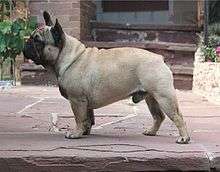 Black Masked Fawn French Bulldog | ||||||||||||||||||||||||||
| Other names | Bouledogue Français | |||||||||||||||||||||||||
|---|---|---|---|---|---|---|---|---|---|---|---|---|---|---|---|---|---|---|---|---|---|---|---|---|---|---|
| Common nicknames | Frenchie | |||||||||||||||||||||||||
| Origin | France([1]) | |||||||||||||||||||||||||
| ||||||||||||||||||||||||||
| ||||||||||||||||||||||||||
| Domestic dog (Canis lupus familiaris) | ||||||||||||||||||||||||||
The French Bulldog is a small breed of domestic dog. "Frenchies" were the result in the 1800s of a cross between bulldog ancestors imported from England and local ratters in Paris (France).[3]
In 2014, they were the fourth most popular registered dog in the United Kingdom[4] and in the U.S. the ninth most popular AKC registered dog breed.[5][6]
History
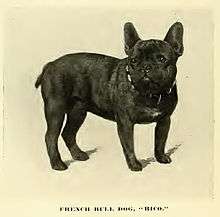


The origin of the modern French Bulldog breed descends directly from the dogs of the Molossians, an ancient Greek tribe. The dogs were spread throughout the ancient world by Phoenician traders. British Molossian dogs were developed into the Mastiff. A sub-family of the Mastiff were the Bullenbeisser, a type of dog used for bull-baiting.[7]
Blood sports such as bull-baiting were outlawed in England in 1835, leaving these "Bulldogs" unemployed.[7] However, they had been bred for non-sporting reasons since at least 1800, and so their use changed from a sporting breed to a companion breed. To reduce their size, some Bulldogs were crossed with terriers, while others were crossed with pugs. By 1850 the Toy Bulldog had become common in England, and appeared in conformation shows when they began around 1860. These dogs weighed around 16–25 pounds (7.3–11.3 kg), although classes were also available at dog shows for those that weighed under 12 pounds (5.4 kg).[7]
At the same time, lace workers from Nottingham, displaced by the Industrial Revolution, began to settle in Normandy, France.[8] They brought a variety of dogs with them, including miniature Bulldogs.[9] The dogs became popular in France and a trade in imported small Bulldogs was created, with breeders in England sending over Bulldogs that they considered to be too small, or with faults such as ears that stood up. By 1860, there were few miniature Bulldogs left in England, such was their popularity in France and due to the exploits of specialist dog exporters.[10]
The small Bulldog type gradually became thought of as a breed, and received a name, the Bouledogue Francais.[10] This Francization of the English name is also a contraction of the words "boule" (ball) and "dogue" (mastiff or molosser). The dogs were highly fashionable and were sought after by society ladies and Parisian prostitutes alike, as well as creatives such as artists, writers, and fashion designers.[10] However, records were not kept of the breed's development as it diverged further away from its original Bulldog roots. As it changed, terrier and Pug stock may have been brought in to develop traits such as the breed's long straight ears, and the roundness of their eyes.[10]
Breed clubs and modern recognition
Bulldogs were very popular in the past, especially in Western Europe. One of its ancestors was the English bulldog. Americans had been importing French Bulldogs for a while, but it was not until 1885 when they were brought over in order to set up an American-based breeding program. They were mostly owned by society ladies, who first displayed them at the Westminster Kennel Club Dog Show in 1896. They arrived again in the following year with even more entries, where the judging of the breed would go on to have future ramifications. The judge in question at the dog show, a Mr. Sven Feltstein, only chose winners with "rose ears" – ears that folded at the tip, as with the standard for English Bulldogs. The ladies formed the French Bull Dog Club of America and created the breed standard which stated for the first time that the "erect bat ear" was the correct type.[11] In the early 20th century they remained in vogue for high society, with dogs changing hands for up to $3,000 and being owned by members of influential families such as the Rockefellers and the J. P. Morgans. The American Kennel Club recognised the breed quickly after the breed club was formed, and by 1906 the French Bulldog was the fifth most popular dog breed in America.[12] In 2013, the American Kennel Club (AKC) ranked the French Bulldog as the 11th most popular breed in the United States, enjoying a sharp rise in popularity from 54th place a decade before, in 2003.[13] By 2014, they had moved up to become the ninth most popular AKC registered dog breed in the USA.[5]
This new Bulldog breed arrived for the first time in England in 1893, with English Bulldog breeds in uproar as the French imports did not meet the new breed standards in place by this time and wanted to prevent the English stock from cross-breeding with the French. The Kennel Club initially recognised them as a subset of the existing English Bulldog breed rather than an entirely new breed.[10] Some English breeders in this period bred the French Bulldogs in order to resurrect the Toy Bulldog breed.[8] On 10 July 1902, at the house of Frederick W. Cousens, a meeting was held to set up a breed club in order to seek individual recognition for the French breed.[11] The adopted breed standard was the same one which was already in use in America, France, Germany and Austria.[8] Despite opposition from Miniature Bulldog (the new breed name for the Toy Bulldog) and Bulldog breeders,[14] in 1905, the Kennel Club changed its policy on the breed and recognised them separate from the English variety, initially as the Bouledogue Francais, then later in 1912 the name changed to French Bulldog.[11]
Description
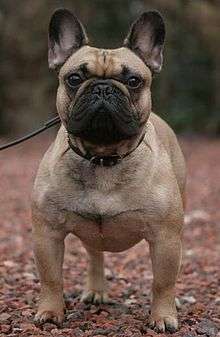
The New Complete Dog Book: Official Breed Standards and All-New Profiles for 200 Breeds, 21st Edition,[15] is an official publication of the American Kennel Club and sets forth the Official Breed Standard for all breeds recognized by the AKC, including the French Bulldog. The French Bulldog should have the appearance of an active, muscular dog, of heavy bone, smooth coat, compactly built, and of medium or small structure. The points should be well distributed and bear good relation one to the other, no feature being in such prominence from either excess or lack of quality that the animal appears deformed or poorly proportioned. In comparison to specimens of different gender, due allowance should be made in favor of the female dogs, which do not bear the characteristics of the breed to the same marked degree as do the male dogs.
Acceptable colors under the breed standard are the various shades of brindle, fawn, tan or white with brindle patches (known as "pied"). The most common colors are brindle, then fawn, with pieds being less common than the other colors. The breed clubs do not recognize any other colors or patterns. This is because some colors come linked with genetic health problems not usually found in the breed, most notably blue coloration, which is linked with a form of alopecia (hair loss or baldness), sometimes known as "Blue Dog Alopecia".[16] Although this is heavily disputed by some organizations,[17] there does appear to be an indication that the health, hair and/or skin conditions are caused by the color pigment (melanin) clumping in the hairshaft itself.[18] Even dogs that are not blue can suffer from "blue dog alopecia" or canine follicular dysplasia. The American Kennel Club states that Frenchies can be brindle, fawn, white, and brindle and white.[9] The skin should be soft and loose, especially at the head and shoulders, forming wrinkles. Coat moderately fine, brilliant, short and smooth.
The AKC French Bulldog Standard[19] states: Acceptable colors - All brindle, fawn, white, brindle and white, and any color except those which constitute disqualification. Unacceptable colors include: black; black and fawn; black and white; cream and white; fawn and black; fawn brindle and white; and gray and white.[5]
The head should be large and square. The top of the skull should be flat but slightly rounded. The stop should be well defined, causing a hollow or groove between the eyes. Muzzle should be broad, deep, and well laid back; The muscles of the cheeks well developed. The nose should be extremely short; Nostrils broad with well defined line between them. The nose and flews should be black, except in the case of lighter-colored dogs, where a lighter color of nose is acceptable. The flews should be thick and broad, hanging over the lower jaw at the sides, meeting the underlip in front and covering the teeth, which should not be seen when the mouth is closed. The under-jaw should be deep, square, broad, undershot, and well turned up. Eyes should be wide apart, set low down in the skull, as far from the ears as possible, round in form, of moderate size, neither sunken nor bulging, and in color dark. No haw and no white of the eye showing when looking forward. Ears shall hereafter be known as the bat ear, broad at the base, elongated, with round top, set high in the head, but not too close together, and carried erect with the orifice to the front. The leather of the ear fine and soft.
The neck should be thick and well arched, with loose skin at throat. The forelegs should be short, stout, straight and muscular, set wide apart. The body should be short and well rounded. The back should be a roach back, with a slight fall close behind the shoulders. It should be strong and short, broad at the shoulders and narrowing at the loins. The chest, broad, deep and full, well ribbed with the belly tucked up.
The hind legs should be strong and muscular, longer than the forelegs, so as to elevate the loins above the shoulders. Hocks well let down. The feet should be moderate in size, compact and firmly set. Toes compact, well split up, with high knuckles and short stubby nails; hind feet slightly longer than forefeet. The tail should be either straight or screwed (but not curly), short, hung V low, thick root and fine tip; carried low in repose. Other than bat ears; black and white, black and tan, liver, mouse or solid black (black means without any trace of brindle) ; eyes of different color; nose other than black except in the case of the lighter-colored dogs, where a lighter color of nose is acceptable; hare lip; any mutilation.
- Full size French Bulldogs in different colours

.jpg)
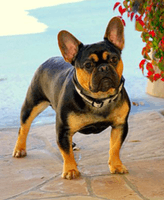
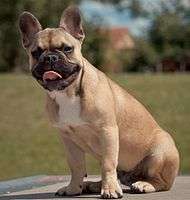
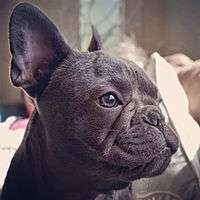
Temperament
The French Bulldog, like many other companion dog breeds, requires close contact with humans. They have fairly minimal exercise needs,[9] but do require at least daily short walks. The French Bulldog is sometimes called "Frog dog" or a "Clown dog". Frog dog is in reference to the unique way they sit with hind legs spread out. Clown dog is because they are known to be fun loving vivacious "clowns of the dog world".[20][21] Their calm nature makes them an excellent choice for apartment dwellers, as does their sensible attitude towards barking.
Their bulk and their compromised breathing system makes it impossible for them to regulate their temperature efficiently. The French bulldog has only a single short coat.[17] What this all means for the dog is that it becomes cold very easily. Also, they will very likely need to have some extra covering inside during the winter if you live in a particularly cold area. These dogs need warm clothing when out in cold weather. Precautions must be taken when exercising during hot or humid weather, as they are prone to heat stroke. It is also recommended that French Bulldogs who live indoors have access to air conditioning to regulate their temperature, provided the air conditioning is not set too low.[9]
French Bulldogs make excellent companions.[9] The French Bulldog rarely barks, and if he does it is to draw attention, to point out that she needs something (like attention), or just because he is not happy he may give the "Frenchie death yodel."[22][23] This breed is patient and affectionate with its owners, especially with children, who are especially protected by the females. French Bulldogs can easily live with other breeds when the proper introductions are done.
They are ranked 58th in Stanley Coren's The Intelligence of Dogs.[24] There are certain exceptions to this average level of canine intelligence; a French Bulldog named Princess Jacqueline which died in 1934 was claimed to understand 20 words, reacting correctly.[25]
Health
A UK breed survey report on 71 dog deaths put the average lifespan of French Bulldogs at 8 to 10 years, while the UK breed club suggests an average of 12 to 14 years.[2][26] The AKC lists that the French Bulldog breed has a lifespan of 11 to 13 years.[27]
As a result of the compacted airway and the bulk of the French bulldog, they have an inability to effectively regulate their body temperature. While a regular canine may suffer to some degree from the heat, to a Frenchie it may be lethal. It is imperative that they be protected from temperature extremes at all times, and that they always have access to fresh water and shade. As they are a brachycephalic breed (see Brachycephalic syndrome), French Bulldogs are banned by several commercial airlines due to the numbers that have died while in the air.[28] This is because dogs with snub noses find it difficult to breathe when they are hot and stressed out. The cargo space in an aircraft can rise as high as 30 °C (86 °F) when waiting on the runway.[29]
Patellar luxation is the dislocation (slipping) of the patella (kneecap). In dogs, the patella is a small bone that shields the front of the stifle joint in its hind legs. This bone is held in place by ligaments. As the knee joint is moved, the patella slides in a groove in the femur. The kneecap may dislocate toward the inside (medial) or outside (lateral) of the leg. This condition may be the result of injury or congenital deformities (present at birth). Patellar luxation can affect either or both legs. Testing is available to predict the presence of patellar luxation in a dog.[30]
Birth and reproduction
French bulldogs frequently require artificial insemination, and caesarean section to give birth, with over 80% of litters delivered this way.[31] [32] As well, many French bulldog stud dogs are incapable of naturally breeding. This is because French Bulldogs have very slim hips, making the male unable to mount the female to reproduce naturally. Typically, breeders must undertake artificial insemination of female dogs. Female French bulldogs can also suffer from erratic or 'silent' heats, which may be a side effect of thyroid disease or impaired thyroid function.
Back and spine
French bulldogs can also suffer from an assortment of back, disk and spinal diseases and disorders, most of which are probably related to the fact that they were selectively chosen from the dwarf examples of the bulldog breed. This condition is also referred to as chondrodysplasia. French bulldogs are prone to having congenital hemivertebrae (also called "butterfly vertebrae"),[33][34] which will show on an x-ray.[35] More advanced technologies such as myelograms, CT scans, or MRIs are used to detect spinal cord compression. Some breeders feel that only dogs that have been x-rayed and checked for spinal anomalies should be bred.
In October 2010, the UK French Bulldog Health Scheme was launched.[26] The scheme consists of three levels, the basic vet check corresponding to the Bronze level, this covers all the Kennel Club Breed Watch points of concern for the breed. The next level, Silver, requires a DNA test for hereditary cataracts, a simple cardiology test, and patella grading. The Gold level requires a hip score and a spine evaluation. The European and UK French Bulldog fanciers and Kennel Clubs are ahead of the Americans and the AKC in moving away from the screw, cork-screw or 'tight' tail (which is an inbreed spinal defect),[36] and returning to the short drop tail which the breed originally had.[37] The UK breed standard now reads: "Tail Undocked, [delete 'very'] short, set low, thick at root, tapering quickly towards tip, preferably [delete 'either'] straight, [delete 'or kinked'] and long enough to cover anus. Never curling over back nor carried gaily."[38][39]
Eyes
French bulldogs have a tendency towards eye issues. Cherry eye, or an everted third eyelid, has been known to occur, although it is more common in English Bulldogs and Pugs. Glaucoma, retinal fold dysplasia, corneal ulcers and juvenile cataracts are also conditions which have been known to afflict French bulldogs. Screening of prospective breeding candidates through the Canine Eye Registration Foundation (CERF) can help eliminate instances of these diseases in offspring. The skin folds under the eyes of the French bulldog should be cleaned regularly and kept dry. Tear stains are common on lighter-colored dogs.
Cultural legacy
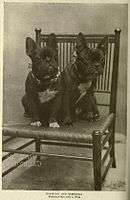 French Bulldogs 1905
French Bulldogs 1905- French Bulldog, white with dark patches
While no French Bulldogs have been Best in Show at either Crufts or the Westminster Kennel Club Dog Show, there was one dominant Bulldog during the 1950s at Westminster. Ch. Bouquet Nouvelle Ami won Best of Breed for eight years in a row; the run only ended with the dog's retirement after the 1960 show.[40] The dog's owner, Amanda West, went on to win Best of Breed with other French Bulldogs for a further ten years.[41] In 2010, a Canadian French Bulldog named Ch. Robobull Fabelhaft I'm On Fire became the first of his breed to win the Non-Sporting Group [42] and make it through for consideration at the Best in Show round, eventually losing to Scottish Terrier Ch. Roundtown Mercedes of Maryscot.[43]
Jason Schwartzman's French Bulldog, Arrow, made a cameo in his HBO detective comedy series Bored to Death in October 2010.[44]
The only French Bulldog aboard the Titanic went down with the ship on 15 April 1912. Robert Daniel, a 27-year-old banker, had purchased the dog, named Gamin de Pycombe, for £150 (the equivalent of $17,000 in today’s prices). A surviving passenger was later quoted as having seen a French Bulldog swimming in the ocean after the ship sank.[45][46][47]
References
- Specific
- ↑ "Official standard from FCI (The Fédération Cynologique Internationale is the World Canine Organisation. It includes 91 members and contract partners (one member per country) that each issue their own pedigrees and train their own judges)", 'Official standard from FCI.'
- 1 2 "Summary results of the Purebred Dog Health Survey for French Bulldogs" (PDF). Kennel Club/ British Small Animal Veterinary Association Scientific Committee. Retrieved 4 April 2011.
- ↑ "Le bouledogue Français, Ses origines", 'Official breed club created in 1898 (fr)'
- ↑ "Top Twenty Breeds In Registration Order For The Years 2013 And 2014" (PDF). The Kennel Club (UK). Retrieved 1 June 2015.
- 1 2 3 "AKC: French Bulldog". The American Kennel Club.
- ↑ AKC: The Most Popular Breeds of 2014
- 1 2 3 Coile (2005): p. 5
- 1 2 3 Leighton (1907): p. 58.
- 1 2 3 4 5 "Get to Know the French Bulldog", The American Kennel Club, retrieved 28 May 2014.
- 1 2 3 4 5 Coile (2005): p. 6
- 1 2 3 Coile (2005): p. 7
- ↑ Coile (2005): p. 8
- ↑ American Kennel Club 2013 Dog Registration Statistics Historical Comparisons & Notable Trends, The American Kennel Club, Retrieved 28 May 2014
- ↑ Leighton (1907): p. 59
- ↑ American Kennel Club (November 11, 2014). The New Complete Dog Book: Official Breed Standards and All-New Profiles for 200 Breeds, 21st Edition. i5 Publishing. p. 912. ISBN 9781621870913.
- ↑ "Introducing the French Bulldog". French Bulldog Club of England. Retrieved 14 October 2011.
- 1 2 10 Things You Didn’t Know about the Blue French Bulldog
- ↑ "Color Dilution Alopecia". Dermatology For Animals. Retrieved June 1, 2015.
- ↑ AKC Breed Standard: French Bulldog
- ↑ French Bulldog Breed: Fun Loving Clown
- ↑ French Bulldog
- ↑ "Crying French Bulldog Asks Owner to Return". YouTube video.
- ↑ "Funny talking French Bulldog". YouTube video.
- ↑ Coren, Stanley (2006). The Intelligence of Dogs. London, UK: Pocket Books. p. 124. ISBN 978-1-4165-0287-6.
- ↑ "French Bulldoge That Could Talk Dies of Pneumonia". Telegraph Herald. Woodward Communications, Inc. 16 October 1934. Retrieved 14 October 2011.
- 1 2 "The French Bulldog – Statement of The Health of The Breed". French Bulldog Club of England. Retrieved 1 June 2015.
- ↑ "French Bulldog Care". American Kennel Club. Retrieved June 3, 2015.
- ↑ Haughney, Christine (6 October 2011). "Banned by Many Airlines, These Bulldogs Fly Private". New York Times. Arthur Ochs Sulzberger, Jr. Retrieved 8 October 2011.
- ↑ White, Madeleine (7 October 2011). "Why are cute, snub-nosed dogs being banned from flying?". The Globe and Mail. Phillip Crawley. Retrieved 14 October 2011.
- ↑ "French Bulldog Health Issues". Retrieved 20 October 2014.
- ↑ Evans, Katy M.; Adams, Vicki J. (2010). "Proportion of litters of purebred dogs born by caesarean section". Journal of Small Animal Practice. 51 (2): 113. doi:10.1111/j.1748-5827.2009.00902.x. PMID 20136998.
- ↑ Pete Wedderburn (6 April 2009). "Why do over 80 per cent of Bulldog births happen by caesarian section?". The Daily Telegraph. Retrieved 5 August 2010.
- ↑ "Hemivertebrae". Mar Vista Animal Medical Center.
- ↑ "Genetic welfare problems of companion animals: Hemivertebrae". Universities Federation for Animal Welfare (UK).
- ↑ "Hemivertebrae". Top Dog Animal Health. Retrieved June 1, 2015.
- ↑ "Talking About Tails". French BulldogZ. Retrieved June 1, 2015.
- ↑ "The Kennel Club Dog Health Group, Annual Report 2013, SPECIAL FEATURE - FRENCH BULLDOGS" (PDF). The Kennel Club (UK). Retrieved 1 June 2015.
- ↑ "About The French Bulldog Tail". Retrieved 1 June 2015.
- ↑ "French Bulldog Allergies". Dog Food Advisor. Retrieved June 1, 2015.
- ↑ "Bulldog Extends Streak, Retirement Will End It". The New York Times. Arthur Ochs Sulzberger, Jr. 9 February 1960.
- ↑ "She's Top Dog Again This Year". The Owosso Argus-Press. Thomas E. Campbell. 10 February 1970. Retrieved 14 October 2011.
- ↑ Non-Sporting Group Results - All Winners of James F. Stebbins Trophy - WestminsterKennelClub.org
- ↑ "Scottish terrier takes Westminster dog show". CBC News Canada. 17 February 2010. Retrieved 14 October 2011.
- ↑ Neff, Lauri (5 October 2010). "'Bored to Death' star's dog gets cameo on show". The Seattle Times. Frank A. Blethen. Retrieved 14 October 2011.
- ↑ Lynch 1992, p. 100.
- ↑ "Frenchies and the Titanic". French Bulldog Club of America. Retrieved 13 December 2012.
- ↑ "the-heroic-dog-the-titanic". www.psychologytoday.com. Retrieved 2015. Check date values in:
|access-date=(help)
- General
- Leighton, Robert (1907). The New Book of the Dog. London; New York: Cassell.
- Coile, D. Caroline (2005). French Bulldogs. Hauppauge, N.Y.: Barron's. ISBN 978-0-7641-3031-1.
External links
| Wikimedia Commons has media related to French Bulldog. |